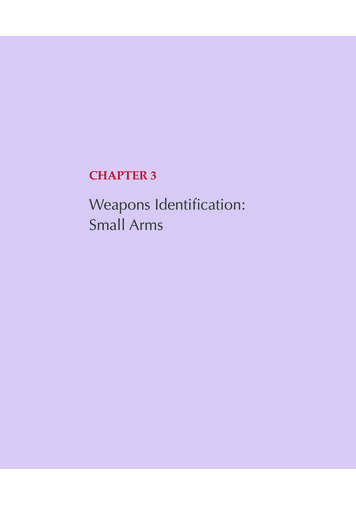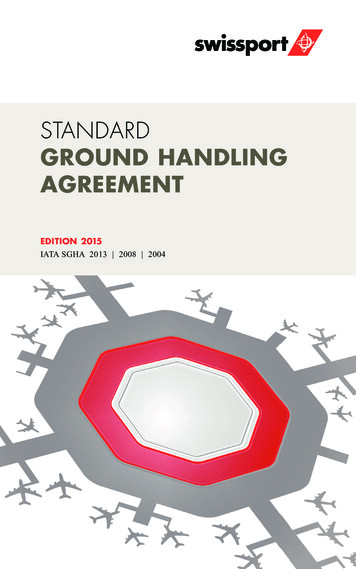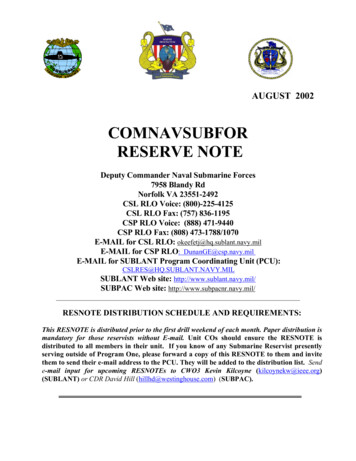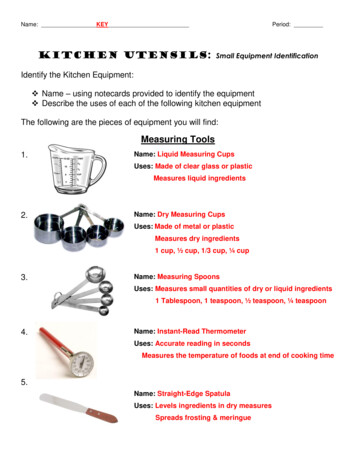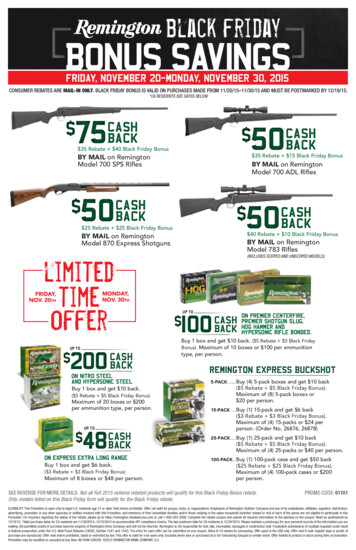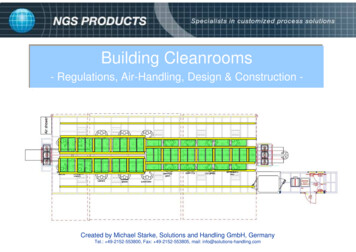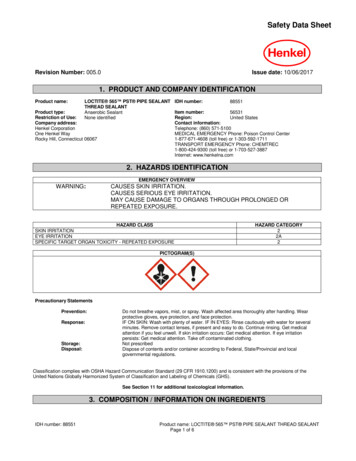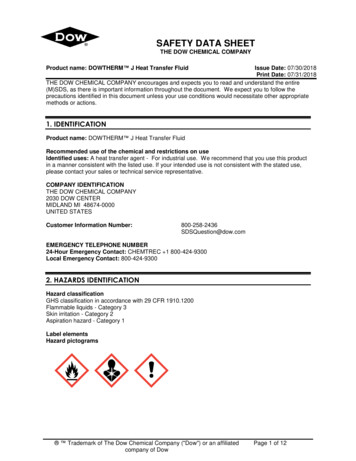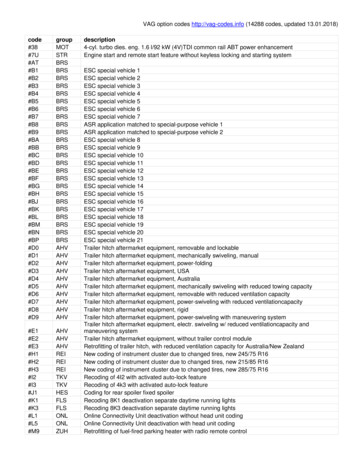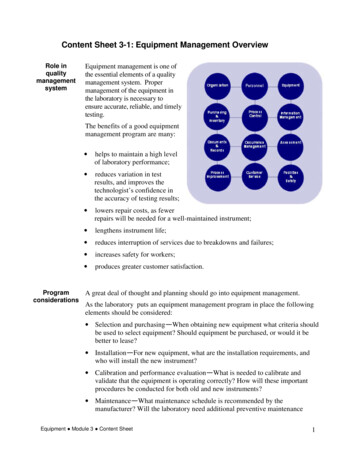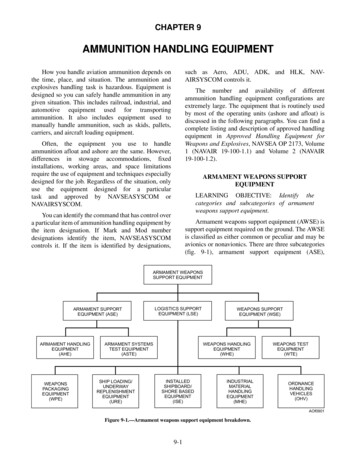
Transcription
CHAPTER 9AMMUNITION HANDLING EQUIPMENTsuch as Aero, ADU, ADK, and HLK, NAVAIRSYSCOM controls it.How you handle aviation ammunition depends onthe time, place, and situation. The ammunition andexplosives handling task is hazardous. Equipment isdesigned so you can safely handle ammunition in anygiven situation. This includes railroad, industrial, andautomotive equipment used for transportingammunition. It also includes equipment used tomanually handle ammunition, such as skids, pallets,carriers, and aircraft loading equipment.The number and availability of differentammunition handling equipment configurations areextremely large. The equipment that is routinely usedby most of the operating units (ashore and afloat) isdiscussed in the following paragraphs. You can find acomplete listing and description of approved handlingequipment in Approved Handling Equipment forWeapons and Explosives, NAVSEA OP 2173, Volume1 (NAVAIR 19-100-1.1) and Volume 2 (NAVAIR19-100-1.2).Often, the equipment you use to handleammunition afloat and ashore are the same. However,differences in stowage accommodations, fixedinstallations, working areas, and space limitationsrequire the use of equipment and techniques especiallydesigned for the job. Regardless of the situation, onlyuse the equipment designed for a particulartask and approved by NAVSEASYSCOM orNAVAIRSYSCOM.ARMAMENT WEAPONS SUPPORTEQUIPMENTLEARNING OBJECTIVE: Identify thecategories and subcategories of armamentweapons support equipment.You can identify the command that has control overa particular item of ammunition handling equipment bythe item designation. If Mark and Mod numberdesignations identify the item, NAVSEASYSCOMcontrols it. If the item is identified by designations,Armament weapons support equipment (AWSE) issupport equipment required on the ground. The AWSEis classified as either common or peculiar and may beavionics or nonavionics. There are three subcategories(fig. 9-1), armament support equipment (ASE),ARMAMENT WEAPONSSUPPORT EQUIPMENTARMAMENT SUPPORTEQUIPMENT (ASE)ARMAMENT E)LOGISTICS SUPPORTEQUIPMENT (LSE)ARMAMENT SYSTEMSTEST EQUIPMENT(ASTE)SHIP LOADING/UNDERWAYREPLENISHMENTEQUIPMENT(URE)WEAPONS SUPPORTEQUIPMENT (WSE)WEAPONS HANDLINGEQUIPMENT(WHE)INSTALLEDSHIPBOARD/SHORE MENT(MHE)WEAPONS 0901Figure 9-1.—Armament weapons support equipment breakdown.9-1
weapons support equipment (WSE), and logisticssupport equipment (LSE).ARMAMENT SUPPORT EQUIPMENTShip Loading and Underway ReplenishmentEquipment consists of connected replenishmentslings, vertical replenishment pole pendants, spreaderbars, beams, missile transfer dollies, etc.The ASE includes all equipment whose primaryfunction is to support the installed aircraft systems andis used primarily by an aircraft intermediatemaintenance department or squadron.Installed Shipboard or Shore-Based Equipmentincludes dunnaging, C-grabs, birail or monorail hoist,tie-downs, davits, bomb elevators, conveyors, and otherfixed or moveable handling equipment.Armament Handling Equipment includesspecial tools used to support the aircraft in providinghandling, movement, installation, configuration,arming, loading and downloading of air-launchedweapons, airborne armament systems, or weaponrelated components. Armament handling equipmentincludes bomb hoists, single hoist loading systems,weapon loaders, boresights, and special tools used toremove, replace, repair, test, assemble, or serviceaircraft bomb racks, missile launchers, installedmachine guns, or gun pod units.Industrial Material Handling Equipmentincludes forklifts, warehouse tractors, pallet trucks,platform trucks, etc.PALLETSLEARNING OBJECTIVE: Identify thepurpose and use of pallets to include safeloads.A pallet is a wood or metal platform used to stackmaterial for movement from one area to another. Youuse pallets to store and handle bombs, cartridge tanks,projectiles, rocket containers, rocket heads, rocketmotors, and unit loads. When live ammunition andexplosives are involved, use metal pallets. Metal palletsare more durable than wood pallets, are not subject towarping, and do not present a fire hazard.WEAPONS SUPPORT EQUIPMENTThe WSE includes all equipment whose primaryfunction is to support explosive ordnance componentsor weapons. The WSE is divided into two categories,weapons handling equipment and weapons testequipment.STANDARD FOUR-WAY WOOD PALLETWeapons Handling Equipment includes bothpeculiar and common ordnance handling andtransportation equipment, as well as tools used forcanning and decanning, magazine handling, andassemblyofweaponsorordnance-relatedcommodities. The WSE includes hoisting beams,weapons carriers, strongbacks, handlift trucks, weaponskids, trailers, bomb trucks (nonself-powered), andtheir associated weapons assembly tables, maintenancestands, and other weapon-related equipment. The WSEsupports both air- and surface-launched weapons.The standard four-way pallet (fig. 9-2) is anine-post wood pallet that provides four-way entry forforklift and pallet trucks. The wings (overhang) at eachend allow sling installations. The slots in the twotop-deck members are used to install steel strapping,which provides load restraint. The pallet measures 48inches in length and 40 inches in width. It has a safeworking load (SWL) of 4,000 pounds. It is ageneral-purpose pallet used primarily for shipment ofdomestic unit loads of ordnance.LOGISTICS SUPPORT EQUIPMENTThe LSE consists of equipment used for packaging,bulk handling storage, or stowage and transportation ofweapons and weapon components within the weaponlogistics cycle. LSE includes weapons packagingequipment, ship loading or underway replenishmentequipment, installed shipboard or shore-based equipment, and industrial materials handling equipment.Weapons Packaging Equipment consists ofmissile containers, pallets, boxes, and fleet-issue unitloads that contain ordnance and ancillary equipment.Figure 9-2.—Standard four-way pallet.9-2
MK 3 MOD 0 PALLETThe Mk 3 Mod 0 pallet (fig. 9-3) is a steel wireweldment. The deck is made of steel wire, formed into agrid pattern of 2-inch squares, and is welded to the decksupports. Nine steel deck supports are welded to thebearing plates and to the deck. The complete pallet isgalvanized. The pallet measures 48 inches in length and40 inches in width. It has an SWL of 4,000 pounds.The Mk 3 Mod 0 pallet is a general-purpose,four-way pallet used to handle unit loads aboard shipand at shore stations. A forklift or pallet truck is used totransport and stack loads. It is also used to hoist loads,by using pallet slings. The Mk 3 Mod 0 pallet is used forfleet issue unit loads.Figure 9-4.—Mk 12 Mod 1 material handling pallet.operations. Twelve locks secure the sides and ends, andfour lifting eyes allow it to be used with hooks onappropriate slings. The deck supports are designed forstacking.MK 12 MOD 1 PALLETThe Mk 12 Mod 1 pallet (fig. 9-4) is a steel wire andformed sheet steel weldment. It consists of a deck,supports, and runners. The deck is made of steel wirebent and assembled into a grid pattern of 2.5-inchsquares. The deck is welded to supports and runners.Steel edge strips protect the wire endings. The palletmeasures 45.5 inches in length and 35 inches in width.It has an SWL of 4,000 pounds.The ammunition pallet crate is used at naval shoreactivities to handle loose ammunition and inert itemsduring on-station handling and transportation. Thispallet is particularly useful in combatant ship loadoutsor offloads at dockside or anchorage wherepalletization is either impractical or inefficient.Projectiles, cartridges, and powder tanks up to 6 inchesin diameter, boxed ammunition, and various inert loadsare typical of the items handled with this pallet crate.The Mk 12 Mod 1 pallet is a four-way pallet used topalletize weapon components and containers forstorage, handling, and shipping. This pallet is used totransport and stack loads, by using a forklift or pallettruck and to hoist loads by using pallet slings. The Mk12 Mod 1 pallet is used for fleet issue unit loads.REVIEW NUMBER 1Q1.For a complete listing and description ofapproved handling equipment, you shouldlook in .AMMUNITION PALLET CRATEThe ammunition pallet crate (fig. 9-5) comes infour sizes with a capacity of 4000 pounds each. Itconsists of a steel four-way pallet on which steel wiresides and ends are attached to form an open-topcontainer. One end of the pallet crate is removable. Ahinge is located in the center so the top half folds downover the lower half for loading and unloadingFigure 9-3.—Mk 3 Mod 0 pallet.Figure 9-5.—Ammunition pallet crate.9-3
Q2.What is the general purpose of the standard,four-way, wood pallet?Q3.What is the safe working load (SWL) of theMk 3 Mod 0 and Mk 12 Mod 2 pallets?Q4.What is the purpose of ammunition palletcrates?CARRIERSLEARNING OBJECTIVE: Identify weaponscarriers and recognize their purpose and use.Carriers are a quick and safe means of attaching acrane cable or other hoisting device to ammunition formovement from one area to another. Some carriers aredesigned for horizontal lifting and some for verticallifting. Others are used for both horizontal and verticallifting. Vertical carriers are used for surface-employedammunition; therefore, only horizontal carriers arediscussed in the following paragraphs.Figure 9-7.—Mk 49 Mod 1 weapons carrier.MK 49 MOD 1 WEAPONS CARRIERThe Mk 49 Mod 1 weapons carrier (fig. 9-7) isconstructed of two steel plates welded together. It hasfour hoisting points and two attaching studs. A fixedstud at the B end of the strongback is engaged in one ofthe weapon suspension lugs. Then, the pivoting stud atthe A end is engaged in the remaining lug and locked inplace with a quick-release pin. The Mk 49 Mod 1weapons carrier is used for horizontal lifting ofweapons with 14-inch suspension lugs and it has anSWL of 2,500 pounds.MK 43 MOD 1 WEAPONS CARRIERThe Mk 43 Mod 1 weapons carrier (fig. 9-6) ismade of a 5/8-inch steel plate with two safety hooksattached by shackles. The carrier has two sets of holesfor attaching the safety hooks, one set spaced at 16 7/8inches and the other at 14 inches. It is used inconjunction with two Mk 49 Mod 1 weapons carriers tolift Mk 82 bombs (500 pounds) in tandem off differentskids and trailers.MK 51 MOD 1 WEAPONS CARRIERThe Mk 51 Mod 1 weapons carrier (fig. 9-8) is analuminum channel that is plate-carrier fitted with twosteel hooks. A fixed position hook with a spring-loadedpinned latch is located at the aft end of the carrier. Theforward hook is adjustable to let you attach the carrierFigure 9-6.—Mk 43 Mod 1 weapons carrier.Figure 9-8.—Mk 51 Mod 1 weapons carrier.9-4
be rotated 180accessibility.to weapons or stores with 14- or 30-inch suspensionlugs. The forward hook is held in place by aquick-release pin. Eight lifting eyes allow you to handleweapons with different centers of gravity.Q2.The Mk 49 Mod 1 weapons carrier isconstructedof.Q3.The Mk 49 Mod 1 and Mk 51 Mod 1 weaponscarriers are used to .Q4.convenientloadREVIEW NUMBER 1 ANSWERSREVIEW NUMBER 2What is the purpose of a carrier?forThe A/E32M-4 maintenance and reconfigurationstand is used to hold the F-14 aircraft weapons railduring general maintenance. It is also used forconfiguring the F-14 weapons rail with associatedbomb racks.Before you attach the carrier to the load, put theadjustable hook in the appropriate suspensionplacement hole, which is held in place by aquick-release pin. With the spring-loaded latchunpinned and depressed, the carrier hooks are engagedwith the weapon lugs. Release the spring-loaded latchand pin the latch in place with a quick-release pin tosecure the load. An instruction plate, mounted on thecarrier, makes it easier for you to match the correctlifting eye to the load. The Mk 51 Mod 1 weaponscarrier is used for horizontal lifting. It has an SWL of4,000 pounds.Q1.degreesA1.For a complete listing and description ofapproved handling equipment, you shouldrefer to NAVSEA OP 2173, Volume 1.A2.The general purpose of the standard four-waywood pallet is for use when shipping domesticunit loads of ordnance.A3.The safe working load (SWL) of the Mk 3 Mod0 and Mk 12 Mod 2 pallets is 4,000 pounds.A4.Ammunition pallet crates are used at navalshore activities to handle loose ammunitionand inert items during on-station handlingand transportation.REVIEW NUMBER 2 ANSWERSWhat is the SWL of the Mk 51 Mod 1 weaponscarrier?A1.A carrier is used as a quick and safe way ofattaching a crane cable or other hoistingdevice to ammunition for movement from onearea to another.A2.The Mk 49 Mod 1 weapons carrier isconstructed of two steel pallets weldedtogether.A3.The Mk 49 Mod 1 and Mk 51 Mod 1 weaponscarriers are used to lift weapons with 14-inchsuspension lugs. The Mk 51 Mod 1 carriercan also lift weapons with 30-inch suspensionlugs.STANDSLEARNING OBJECTIVE: Recognize thepurpose and use of stands to include theA/E32M-4 maintenance and reconfigurationstand, the A/F 32K-1/1A bomb assembly stand,and the A/F32K-10 small bomb assemblyplatform stand.Stands are metal frameworks used to support aweapon that is being assembled or maintained. Standsmay be immobile or equipped with pivoting casters.The stands discussed in the following paragraphs are ofthe immobile type.A/E32M-4 MAINTENANCE ANDRECONFIGURATION STANDThe A/E32M-4 maintenance and reconfigurationstand (fig. 9-9) is made of steel and aluminum. Thestand consists of maintenance ring assembliesMXK-663/E32M-4 (forward), MXK-664/E32M-4(aft), and deck post assembly MXK-665/E32K-4 thatsupports each ring assembly. The ring assemblies canFigure 9-9.—A/E32M-4 maintenance and reconfigurationstand.9-5
A4.center insert, and three tray assemblies. Rollers arepermanently affixed to the tables. Folding legs locatedat both ends of each table assembly provides support,which are unfolded and pinned into position. An insertis placed in the gap between the tables and secured withfour bolts. There are also three tray assemblies withrollers on top. When placed on the main standassembly, the trays ride on the permanent rollers,allowing them to be pushed along the length of thestand. The top-mounted rollers actually contact the skinof the weapon and support its weight, permitting a360-degree rotation of any weapon and allowing accessto screws and other parts.The SWL of the Mk 51 Mod 1 weapons carrieris 4,000 pounds.A/F 32K-1/1A BOMB ASSEMBLY STANDThe A/F 32K-1/1A bomb assembly stand (fig.9-10) consists of three interchangeable andinterlocking 49-inch sections. The stand must besecured to the deck. It has four trays that are placed ontop of conveyor rollers to permit a 360-degree rotationof the weapon. Stops are located at each end to preventthe trays from moving beyond the end of the conveyor.Each of the sections is collapsible for stowagepurposes.The A/F32K-10 is primarily designed for use onamphibious assault ships (LPH/LHA/LHD). It is usedin a predesignated magazine or bomb assembly area inconjunction with an overhead rail and hoist system forassembling bombs of various weights and sizes.The stand is designed to support Mk 80 seriesgeneral-purpose bombs during the assembly process.However, the stand may be used to support variousother weapons during the assembly process.A/F32K-10 SMALL BOMB ASSEMBLYPLATFORM STANDHOISTING BARSLEARNING OBJECTIVE: Recognize thepurpose and use of hoisting bars.The A/F32K-10 small bomb assembly platformstand (fig. 9-11) consists of two table assemblies, aFigure 9-10.—A/F 32K-1/1A bomb assembly stand.9-6
Figure 9-11.—A/F32K-10 small bomb assembly platform stand.Hoisting bars are used for carrying, lifting, andhandling weapons. They are normally used duringweapons handling and loading evolutions.AERO 64A1 HOISTING BARThe Aero 64A1 hoisting bar (fig. 9-12) consists of acradle, strap, and two carrying handles. The cradle is aFigure 9-12.—Aero 64A1 hoisting bar.9-7
Figure 9-13.—Aero 68A hoisting bar.HLU-256/E MANUAL HOISTING BARweldment frame that has four padded braces. Thehandles have knurled gripping surfaces. A missile issecured in the cradle by a web strap attached to thetie-down assembly and the bar buckle.The HLU-256/E manual hoisting bar (fig. 9-14)consists of a round steel bar with a removable bombnose plug connector and tail stop plates on one end. Aquick-release pin secures the nose plug connector to thebar. When a tee configuration is desired, the nose plugcan be relocated to a position at the bar's midpoint. Theopposite end of the bar can be used as a lift point in thebomb's tail end. A tail stop is situated 18 inches fromthis end of the bar.Two Aero 64A1 hoisting bars must be used tomanually lift a Sparrow missile from a missile skid toan aircraft wing or fuselage-mounted launcher.AERO 68A HOISTING BARThe Aero 68A hoisting bar (fig. 9-13) is a barwithin a bar that has a hook assembly attached.Extending the internal bars 15 7/8 inches each canincrease the length of the bar.The HLU-256/E manual hoisting bar is used tomanually lift Mk 80 series general-purpose bombs thatweigh up to 1,000 pounds during aircraftloading/unloading operations. It is also used forweapons assembly purposes.To manually lift the weapon, you must hook theAero 68A hoisting bar into the weapon lugs. This bar isused to handle or transport any weapon having standardlugs. Weapons weighing up to 1,000 pounds can belifted if two bars are used.REVIEW NUMBER 3Q1.What is the purpose of stands?Figure 9-14.—HLU-256/E manual hoisting bar.9-8
Q2.MK 18 MOD 1 HANDLING BEAMWhat maintenance ring assembly is usedwith the A/E32M-4 maintenance and reconfiguration stand?Q3.What is the purpose of the A/E32M-4maintenance and reconfiguration stand?Q4.What is the maximum rotation of the A/F32K-1/1A bomb assembly stand?Q5.The Aero 64A1 hoisting bar is used to.Q6.When you use two Aero 68A hoisting bars,what is the maximum weight that can belifted?Q7.What hoisting bar is used to manually lift Mk82 bombs?The Mk 18 Mod 1 handling beam (fig. 9-15) is astructural steel weldment that consists of a cylindricalbeam with a lifting eye at its center of gravity andhook-extender assemblies with safety hooks at eachend. The Mk 18 Mod 1 is used during connectedunderway replenishment operations for transferringpalletized unit loads. The beam is designed for couplingwith cargo hoisting assembly Mk 20 Mod 0, andnormally it is used with adjustable pallet slings formaking the transfer.REVIEW NUMBER 3 ANSWERSBEAMSLEARNING OBJECTIVE: Recognize thepurpose and use of beams and identify theloads that each carries.A beam is a rigid metal item that has an I, H, T, orcircular cross section. The rigid portion is fitted with alifting eye, a sling or sling attaching points, and devicesfor attaching a load.A1.Stands are used to support a weapon beingassembled or maintained.A2.The MXK-663/E32M-4 (forward) maintenance ring assembly is used with the A/E32M-4 maintenance and reconfigurationstand.A3.The A/E 32M-4 maintenance and reconfiguration stand is used to hold the F-14aircraft weapons rail during general maintenance.Figure 9-15.—Mk 18 Mod 1 handling beam.9-9
A4.The maximum rotation of the A/F 32K-1/1Abomb assembly stand is 360 degrees.A5.The Aero 64A1 hoisting bar is used tomanually lift Sparrow missiles.A6.When using two Aero 68A hoisting bars,1,000 pounds is the maximum weight that canbe lifted.A7.The HLU-256/E hoisting bar is used tomanually lift Mk 82 bombs.ADU-399/E GUIDED MISSILE HOISTINGBEAMThe ADU-399/E guided missile hoisting beam (fig.9-16) is an aluminum weldment that consists of a beamsupported on forklift channels and structural members.These components form the base assembly.Rubber-lined cradles mounted fore and aft on the beamprevent metal-to-metal contact. The cradles have sidesupports held in position by quick-release pins. Whenyou are loading or unloading the beam, remove th
MK 3 MOD 0 PALLET The Mk 3 Mod 0 pallet (fig. 9-3) is a steel wire weldment.Thedeckismadeofst
